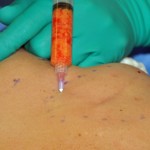The field of stem cell research has spurned a lot of new potential medical applications. Enthusiasm is high as to what stem cells may do and many almost give them magical properties and disease curative capabilities. Much of this enthusiasm is at least partially warranted based on a large number of animal and cell culture studies which show some extraordinary results.
The allure of stem cells for plastic surgery applications has not gone unnoticed. Their use in plastic surgery is spurned by several driving factors. The first is their autologous nature and our familiarity of harvesting a fat donor source of stem cells through liposuction. Many problems in plastic surgery particularly of cosmetic concern is the aging of soft tissues, exactly what stem cells can theoretically help reverse. But the pivotal technology that brings stem cell use in plastic surgery a reality is that of commercial stem cell production. There are numerous companies that have emerged that offer to grow stem cells from patients in a timely manner and at a reasonable expense. Since these are cells that are being transplanted back into the patient from which they came, there is no objection yet to their use by the FDA.
Now that stem cells are available, the next question is exactly what in plastic surgery are they good for? Stem cells are different from that of injectable fat grafting in that volume is not being replaced. Fat injections add substantial volume which is why they have made facial volumetric enhancement and breast and buttock augmentation possible. While these fat grafts do have some stem cells in them, they are not really true stem cell injections. The stem cells are inadvertent passengers along with the much greater number of fat cells. The use of such monikers as ‘stem cell injections’ and stem cell-enhanced fat injections’ used by some surgeons are marketing terms and not indicative of scientific reality.

The other application concept is that of pure stem cell injections alone. It would be used by injecting the cell concentrate into the desired tissue target with the intent of creating a rejuvenative effect much like the way we use synthetic injectable fillers today. Whether they could serve as an alternative to injectable fillers creating a delayed volume effect through cell stimulation or conversion to adipocytes or fibroblasts is theoretically possible. Injecting directly into facial wrinkles and folds would be easy to do as stem concentrates would flow through very small needles. Could skin thickness and texture be improved by direct stem cell injections?
While stem cells are now available and their biologic appeal is obvious, the cosmetic applications for which they would be most beneficial is not yet known. This is sure to create a flurry of clinical activity in this area from many inventive and entrepreneurial cosmetic practitioners in the near future.
Dr. Barry Eppley
Indianapolis, Indiana


